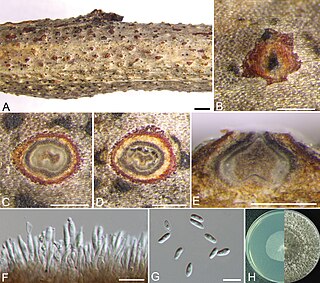
Diaporthe eres is a fungal plant pathogen, which is the type species of genus ''Diaporthe''. It causes canker disease in a wide variety of hosts. This species has a long history, having been described many times under various synonyms, for instance, the fungus was illustrated by James Sowerby in 1803 under the name Sphaeria ciliaris, attributed to Bulliard. The name D. eres has been proposed for conservation in order to avoid bothersome name changes due to priority.
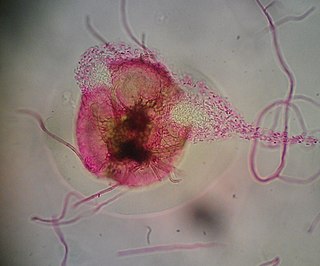
A pycnidium is an asexual fruiting body produced by mitosporic fungi, for instance in the order Sphaeropsidales or order Pleosporales. It is often spherical or inversely pearshaped (obpyriform) and its internal cavity is lined with conidiophores. When ripe, an opening generally appears at the top, through which the pycnidiospores escape.

Anamylopsora is an ascomycete genus of lichenized fungi. In 1991 the Norwegian mycologist Einar Timdal decided to create this new genus for the species previously called Lecidea pulcherrima. A monotypic family, Anamylopsoraceae, was even proposed for this taxon due to distinctive features of the asci, pycnidia and the ascoma, but phylogenetic analysis later indicated that it belongs in the Baeomycetaceae.
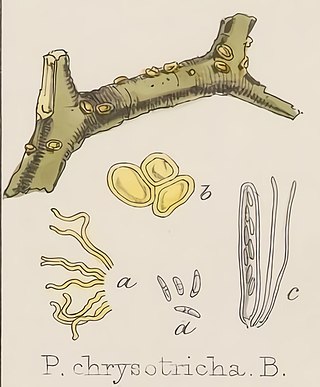
Dicephalospora is a genus of fungi in the family Sclerotiniaceae. The genus was circumscribed by mycologist Brian Spooner in 1987. These ascomycete fungi occur on rotten wood, twigs and leaf stems.
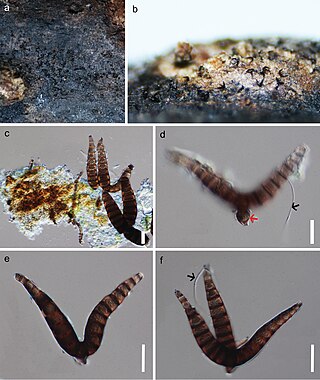
Iodosphaeria is a genus of fungi in the family Amphisphaeriaceae. Most of species of Iodosphaeria are saprobes that feed on dead leaves and twigs of various hosts such as the Argentine white pine. No species have been reported as pathogenic to hosts. As of January 2022, it contains eleven species.

Ceratocystiopsis is a genus of ascomycete fungi in the family Ophiostomataceae, which infect bark.
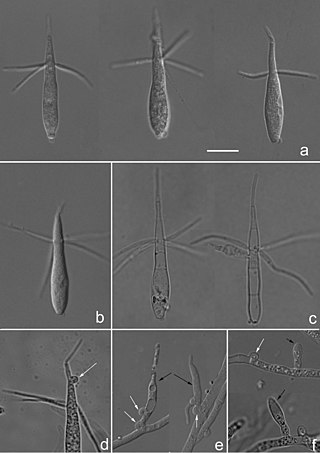
The Classiculomycetes are a class of fungi in the Pucciniomycotina subdivision of the Basidiomycota. The class contains a single order, the Classiculales, which in turn contains the single family Classiculaceae. The family contains two monotypic genera.
Parapterulicium is a genus of fungi in the order Russulales. The genus contains two species found in Brazil and Argentina.

Celoporthe is a genus of ascomycete fungi within the family Cryphonectriaceae. It was circumscribed in 2006 to contain the type species Celoporthe dispersa, which was found in South Africa growing on trees in the Myrtales. In 2011, several species were described from China and Indonesia: C. eucalypti, C. guangdongensis, C. indonesiensis, and C. syzygii. Molecular analysis of DNA sequences revealed an additional two species from South Africa in 2013, C. fontana and C. woodiana and in 2020 three more species from Hawaii were added to the genus.

Hydnellum glaucopus is a species of tooth fungus in the family Bankeraceae. Found in Europe, it was described as new to science in 1969 by mycologists Rudolph Arnold Maas Geesteranus and John Axel Nannfeldt. Fruit bodies contain cyathane diterpenes called glaucopins that have anti-inflammatory activity in laboratory tests. It is considered vulnerable in Switzerland.
Hydnellum lundellii is a species of tooth fungus in the family Bankeraceae. Found in Europe, it was described as new to science in 1969 by mycologists Rudolph Arnold Maas Geesteranus and John Axel Nannfeldt.
Hydnellum lepidum is a species of tooth fungus in the family Bankeraceae. Found in Europe, it was described as new to science in 1975 by Dutch mycologist Rudolph Arnold Maas Geesteranus.

Xanthagaricus necopinatus is a species of the fungal family Agaricaceae. This species is the first generic report for Bangladesh. It was found in Chondrima Uddan, Dhaka district of Bangladesh.

Xanthagaricus flavosquamosus is a species of the fungal family Agaricaceae.This species is described from China.

Rossbeevera griseobrunnea is a species of the fungal family Boletaceae. This species was first described in April 2019 from southern China.

The Chlorociboriaceae are a family of "cup fungi" in the order Helotiales, with type genus Chlorociboria. A second genus Brahmaculus, which occurs only in the southern hemisphere, was added in 2021.

Parmelia omphalodes is a species of foliose lichen in the family Parmeliaceae. It is one of the several dozen lichen species first described in 1753 by Carl Linnaeus. Swedish lichenologist Erik Acharius transferred it to the genus Parmelia in 1803. The lichen is widely distributed, having been recorded in Asia, Africa, Europe, and North and South Americas. Morphologically similar–but genetically distinct–species include Parmelia discordans and P. pinnatifida.
Agaricus angusticystidiatus is a species of fungus in the family Agaricaceae. It has a diameter of 40–80 mm and is found in Southeast Asia.
Punjabia is a genus of fungi in the family Psathyrellaceae. The genus is monotypic and contains the single species Punjabia pakistanicus which was previously classified as Coprinellus pakistanicus.
Carex boecheriana is a species of sedge in the family Cyperaceae, native to Greenland. It is a host of the smut fungi Anthracoidea capillaris.














